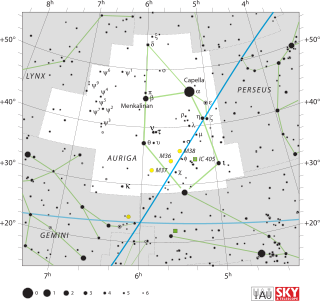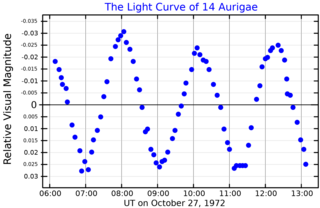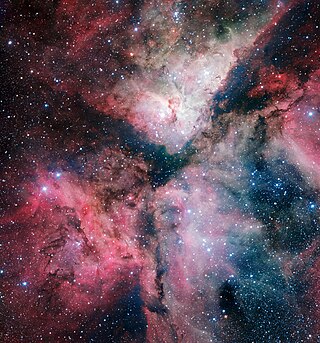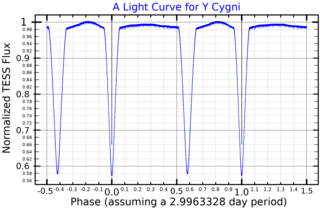
Mintaka, designation Delta Orionis and 34 Orionis, is a multiple star system some 1,200 light-years from the Sun in the constellation of Orion. Together with Alnitak and Alnilam, the three stars form Orion's Belt, known by many names among ancient cultures. The star is located very close to the celestial equator. When Orion is near the meridian, Mintaka is the rightmost of the Belt's stars when viewed from the Northern Hemisphere facing south.

Beta Aurigae, officially named Menkalinan, is a binary star system in the northern constellation of Auriga. The combined apparent visual magnitude of the system is 1.9, making it the second-brightest member of the constellation after Capella. Using the parallax measurements made during the Hipparcos mission, the distance to this star system can be estimated as 81.1 light-years, give or take a half-light-year margin of error.

Epsilon Aurigae is a multiple star system in the northern constellation of Auriga, the charioteer. It is an unusual eclipsing binary system comprising an F0 supergiant and a companion which is generally accepted to be a huge dark disk orbiting an unknown object, possibly a binary system of two small B-type stars. The distance to the system is still a subject of debate, but data from the Gaia spacecraft puts its distance at around 3,300 light years from Earth.

Zeta Aurigae, or ζ Aurigae, is a binary star system in the northern constellation of Auriga. Based upon parallax measurements, this system is approximately 860 light-years distant from the Sun. It has a combined apparent visual magnitude of 3.75, which is bright enough to be seen with the naked eye.

Chi Aurigae, Latinized from χ Aurigae, is the Bayer designation for a binary star system in the northern constellation of Auriga. It is visible to the naked eye with an apparent visual magnitude of 4.74. The distance of Chi Aurigae is determined at 3,900 ly based on spectroscopic observations. Parallax measurements by the Hipparcos spacecraft were unsuccessful because the parallax error was bigger than the value itself, while the Gaia spacecraft measured the parallax with a 22% error, giving a distance of 3590±750 ly. The brightness of the star is diminished by 1.26 in magnitude from extinction caused by intervening gas and dust.

14 Aurigae is a quadruple star system located 269 light years away from the Sun in the zodiac constellation of Auriga. It has the variable star designation KW Aurigae, whereas 14 Aurigae is the Flamsteed designation. It is visible to the naked eye as a faint, white-hued star with a combined apparent visual magnitude of 5.01. The system is moving closer to the Sun with a heliocentric radial velocity of −9 km/s.
40 Aurigae is a binary star in the constellation Auriga. Its apparent magnitude is 5.345, meaning it can just barely be seen with the naked eye. Based on parallax estimates made by the Hipparcos spacecraft, the system is located some 340 light-years away.

RT Aurigae is a yellow supergiant variable star in the constellation Auriga, about 1,500 light years from Earth. Although its brightness is variable, it as consistently visible to the naked eye under good observing conditions.

AR Aurigae, also known by its Flamsteed designation 17 Aurigae, is a binary star in the constellation Auriga. Based on parallax measurements made by the Hipparcos spacecraft, it is approximately 461 light-years from Earth.

Psi6 Aurigae, Latinized from ψ6 Aurigae, is a spectroscopic binary star in the northern constellation of Auriga. It is a dim, naked eye star with an apparent visual magnitude of +5.22. Based upon a measured annual parallax shift of 9.05 ± 0.38 mas, it is approximately 360 light-years distant from the Earth.

Omicron Cassiopeiae is a triple star system in the constellation Cassiopeia. It is approximately 700 light-years from Earth, based on its parallax. It is visible to the naked eye with a slightly variable apparent magnitude of about 4.5.

HR 2554, also known as V415 Carinae and A Carinae, is an eclipsing spectroscopic binary of the Algol type in the constellation of Carina whose apparent visual magnitude varies by 0.06 magnitude and is approximately 4.39 at maximum brightness. It is easily visible to the naked eye of a person far from brightly-lit urban ares. Its primary is a G-type bright giant star and its secondary is an A-type main-sequence star. It is approximately 553 light-years from Earth.

IU Aurigae is a triple star system in the constellation Auriga, consisting of an eclipsing binary pair orbiting a third component with a period of 335 years. This system is too faint to be viewed with the naked eye, having a peak apparent visual magnitude of 8.19.

Delta Circini, is a multiple star system located in the constellation Circinus. Delta Circini is also known as HR 5664, and HD 135240. The system has a combined apparent visual magnitude of +5.09, and is located at a distance of about 700 pc (2,300ly) from the Sun.

1 Persei is an eclipsing binary star in the constellation Perseus. Its uneclipsed apparent magnitude is 5.49. The binary star consists of two B2 type main-sequence stars in a 25.9 day eccentric orbit. The stars are surrounded by a faint cloud of gas visible in mid-infrared, although whether they are the origin of the gas or simply passing through it is unclear.

14 Lacertae is a binary star system in the northern constellation Lacerta, located around 1,600 light years away. It has the variable star designation V360 Lacertae; 14 Lacertae is the Flamsteed designation. The system is barely visible to the naked eye in good seeing conditions, having a peak apparent visual magnitude of 5.91. It is moving closer to the Earth with a heliocentric radial velocity of −16 km/s.

42 Persei is a binary star system in the northern constellation of Perseus. It has the Bayer designation n Persei, while 42 Persei is the Flamsteed designation. The system is visible to the naked eye as a dim, white-hued point of light with an apparent visual magnitude of 5.11. It is located around 93 parsecs (302 ly) distant from the Sun, but is drifting closer with a radial velocity of −12.4 km/s.

QZ Carinae is a multiple star system in the constellation Carina. It is the brightest member of the loose open cluster Collinder 228 and one of the brightest stars in the Carina Nebula. The apparent magnitude is variable from +6.16 to +6.49 with a period of 6 days.

Y Cygni is an eclipsing and double-lined spectroscopic binary star system in the constellation of Cygnus. It is located about 4,900 light-years from Earth. The system was one of the first binaries with a convincing detection of the apsidal precession.

CX Draconis is an interacting binary star system in the northern constellation of Draco, abbreviated CX Dra. It has the designation HD 174237 in the Henry Draper Catalogue; CX Draconis is the variable star designation. This is a double-lined spectroscopic binary system with a near circular orbit. The brightness of the system undergoes long-term irregular fluctuations, ranging from an apparent visual magnitude of 5.68 down to 5.99. Based on parallax measurements, it is located at a distance of approximately 1,150 light years from the Sun.
















